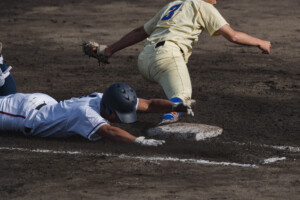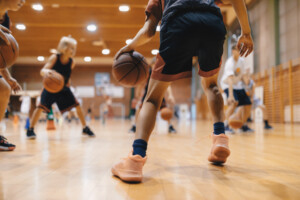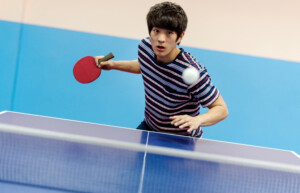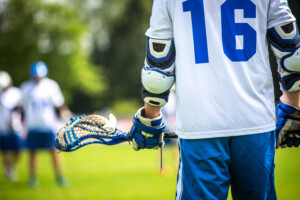Highlights:
- Concussion is a brain injury and is among the most common injuries in contact and collision sport.
- Published in June 2023, the Amsterdam Consensus Statement summarizes the latest research in concussion as of the 6th International Conference on Concussion in Sport.
- This article shares updates based on that international consensus that can be used to optimize concussion processes in your sport.
- The author presents the updates by linking them to the 12 R’s of clinical concussion management (Recognize, Reduce, Remove, Re-evaluate, (Relative) Rest, Rehabilitate, Refer, Recover, Return-to-Learn/Return-to-Sport, Reconsider, Refine, Retire).
- The author also provides links to Canadian concussion resources and timelines about national updates.
Introduction
 People involved in sport tend to know someone who has had a concussion. Concussions are brain injuries that happen after direct hits to or transmitted indirectly to the head. Concussions lead to many different symptoms reported by the injured athlete or sport participant and by other individuals observing signs (Davis et al., 2023a).1 In the case of a suspected concussion, the injured athlete or participant should be removed from play or sport and be followed up with a healthcare professional (Patricios et al., 2023a).2 Fortunately, most individuals recover in the initial 4 weeks after a concussion, although up to 20% to 30% of youth and adults may have symptoms that last longer (Schneider et al., 2021; Zemek et al., 2016).3 4
People involved in sport tend to know someone who has had a concussion. Concussions are brain injuries that happen after direct hits to or transmitted indirectly to the head. Concussions lead to many different symptoms reported by the injured athlete or sport participant and by other individuals observing signs (Davis et al., 2023a).1 In the case of a suspected concussion, the injured athlete or participant should be removed from play or sport and be followed up with a healthcare professional (Patricios et al., 2023a).2 Fortunately, most individuals recover in the initial 4 weeks after a concussion, although up to 20% to 30% of youth and adults may have symptoms that last longer (Schneider et al., 2021; Zemek et al., 2016).3 4
Meanwhile concussion research continues to evolve rapidly. Every 4 years, since 2001, new international statements on concussion have been published. Published in 2017, the Berlin Consensus Statement provided a summary of the evidence at the time of the 5th International Conference on Concussion in Sport, with resulting recommendations for managing concussion (Aubry et al., 2002; McCrory et al., 2005, 2009, 2013, 2017).5-9 These recommendations were meant to be adapted to various sport environments around the globe.
Canada began its harmonized approach to sport-related concussion in 2017. Back then, Prime Minister Trudeau asked 2 federal cabinet ministers (Minister of Sport and Persons with Disabilities and Minister of Health to work together to roll out “a pan-Canadian concussion strategy.” He also called for them to jointly raise awareness of concussion treatment with parents or guardians, coaches, sport participants and athletes.
 Canada’s national injury prevention charity, Parachute, led the development and online publication of the Canadian Guideline on Concussion in Sport, a first for Canada. Parachute’s Concussion Expert Advisory Committee informed that Guideline, with funding from the Public Health Agency of Canada and support from Sport Canada. Along with members of its Advisory Committee, Parachute also worked with national sport organizations to develop sport-specific protocols, processes and resources on concussion (for schools, sport organizations and healthcare professionals), including sport-specific, return-to-sport strategies. More recently, based on identified barriers to implementation, Parachute and a team of researchers at the Sport Injury Prevention Research Centre developed a toolkit to facilitate use of protocols and to assist sport organizations in applying the Canadian Guideline on concussion in Sport in their sport environment (Schneider et al., 2020).10
Canada’s national injury prevention charity, Parachute, led the development and online publication of the Canadian Guideline on Concussion in Sport, a first for Canada. Parachute’s Concussion Expert Advisory Committee informed that Guideline, with funding from the Public Health Agency of Canada and support from Sport Canada. Along with members of its Advisory Committee, Parachute also worked with national sport organizations to develop sport-specific protocols, processes and resources on concussion (for schools, sport organizations and healthcare professionals), including sport-specific, return-to-sport strategies. More recently, based on identified barriers to implementation, Parachute and a team of researchers at the Sport Injury Prevention Research Centre developed a toolkit to facilitate use of protocols and to assist sport organizations in applying the Canadian Guideline on concussion in Sport in their sport environment (Schneider et al., 2020).10
Updates to International recommendations
The Amsterdam International Consensus Statement on Concussion in Sport was published in June 2023 in the British Journal of Sports Medicine (Patricios et al., 2023a).2 This statement summarizes outputs from the 6th International Conference on Concussion in Sport and evaluates the research evidence up to the time of the meeting (Schneider et al., 2022).11The COVID19 pandemic delayed the conference by 2 years, causing 6 years to separate the 5th and 6th International Consensus conferences and their resulting statements.
It was my pleasure to co-chair the scientific committee and co-first author the resulting 6th Consensus Statement. In this process, we engaged 114 co-authors worldwide and reviewed 78,018 citations (Schneider et al., 2023a).12 That huge team effort resulted in the Amsterdam Consensus Statement (Patricios., 2023a).2 We had amazing contributions from researchers and clinicians who work with many different sports and in multiple countries around the globe. After 4 years of preparation, a two day open conference with over 600 attendees was held in Amsterdam in October 2022 (Schneider et al., 2023a).12 A one-day Expert Panel meeting followed the conference with a fourth day dedicated to developing the new concussion “tools,” including: an updated Concussion Recognition Tool, a Sport Concussion Assessment Tool and a new Sport Concussion Office Assessment Tool (Davis et al., 2023b, 2023c; Echemendia et al., 2023a, 2023b; Patricios et al., 2023b).13-17
The resulting Consensus Statement summarizes the key findings from the 10 topics reviewed and additional areas relevant to concussion management based on the latest available evidence.1 12 18-27 In our “Calling Clinicians to Action!” editorial, we invite all stakeholders in concussion to adapt the recommendations to apply them in their local environment (Schneider & Patricios, 2023).28And in doing so, we’re encouraging stakeholders to optimize the care of participants and athletes at risk of concussion and also to enhance the detection and management of concussion in sport.
This article summarizes the latest International Consensus Statement on Concussion in Sport2 that includes recommendations for how to prevent, detect and manage concussion in sport (Patricios et al., 2023a). In this article, we share key principles and links to resources to assist you and your team in adopting the most up-to-date recommendations for managing sport participants and athletes, those with concussion or those at risk of concussion.
What’s new from the Amsterdam Consensus Statement?
Beyond highlighting in this article some of the new outcomes of relevance to various sport stakeholders, even more details are available in the Consensus Statement itself. Additional outputs from the Statement are found in 2 issues of the June 2023 British Journal of Sport Medicine: volume 57, issue 11 and volume 57, issue 12.
- The first R is Reduce because prevention is key to reducing concussions in sport. Ultimately, if we can prevent concussions before they happen then sport will be safer for participants and athletes, and concussions will be less of a burden on public health. Informed by the systematic review on prevention (Eliason et al., 2023)24, recommended strategies to reduce or prevent concussions involve (Patricios et al., 2023a):2
- policies or rule changes (for example, disallowing body checking in youth ice hockey, limiting contact practice time in American football)
- personal protective equipment (for example, wearing mouthguards in youth ice hockey)
- training strategies (for example, using neuromuscular training in warm-ups)
- concussion management strategies to reduce recurrent concussions (for example, mandating removal from play if concussion is suspected, adopting a clearance process to return to play)
In the case of a suspected concussion, it’s important to Recognize and Remove the sport participant or athlete from the “at risk” situation and ensure they have appropriate follow-up with a healthcare professional. The Concussion Recognition Tool 6 (CRT6, 2023)29 is a tool meant to be used by all stakeholders involved in sport, including parents or guardians, coaches, players, referees and administrators. The CRT6 helps them to recognize when a concussion may have happened. If you think of most sporting events, especially in grassroots and youth sport, there isn’t usually a healthcare professional at the sideline (Echemendia et al., 2023a).15 Thus, the CRT6 includes a stepwise process including urgent signs (when to call an ambulance), visible clues of concussion, symptoms of concussion and questions related to participant or athlete awareness of their situation. In the case of a suspected concussion, the player should be removed and have follow-up medical evaluation. The CRT6 can be used by anyone working in sport, especially within contact and collision sports.
 The SCAT6 is a tool that includes multiple different tests. The SCAT6 is meant for use by healthcare professionals to Recognize concussion as part of their clinical evaluation of concussion on the sideline and in the initial 3 days after concussion (SCAT6, 2023; Child SCAT6, 2023).30 31 SCAT6 is an evolution of the previous SCAT5. To Re-evaluate sport participants, athletes and patients with concussion in office settings, there’s the Sport Concussion Office Assessment Tool, abbreviated as the SCOAT6 (SCOAT6, 2023; Child SCOAT6, 2023).32 33 The SCOAT6 is a newly developed tool that combines previously established tests that assess different areas of function that may be affected by concussion (for example, balance, eye movement, coordination, neck function, thinking while moving, …). The SCOAT6 is meant to provide a suite of tests for healthcare professionals to use in the office setting from 3 to 30 days and beyond. Child versions of the adult tools are intended for healthcare professionals to use with children ages 8 to 12 (Child SCAT6, 2023; Child SCOAT6, 2023).
The SCAT6 is a tool that includes multiple different tests. The SCAT6 is meant for use by healthcare professionals to Recognize concussion as part of their clinical evaluation of concussion on the sideline and in the initial 3 days after concussion (SCAT6, 2023; Child SCAT6, 2023).30 31 SCAT6 is an evolution of the previous SCAT5. To Re-evaluate sport participants, athletes and patients with concussion in office settings, there’s the Sport Concussion Office Assessment Tool, abbreviated as the SCOAT6 (SCOAT6, 2023; Child SCOAT6, 2023).32 33 The SCOAT6 is a newly developed tool that combines previously established tests that assess different areas of function that may be affected by concussion (for example, balance, eye movement, coordination, neck function, thinking while moving, …). The SCOAT6 is meant to provide a suite of tests for healthcare professionals to use in the office setting from 3 to 30 days and beyond. Child versions of the adult tools are intended for healthcare professionals to use with children ages 8 to 12 (Child SCAT6, 2023; Child SCOAT6, 2023).
An important change supported by recent research is the positive role of exercise introduced early in the treatment of concussion (Leddy et al., 2023).25 The Amsterdam Consensus Statement recommends relative Rest for only the initial 24 to 48 hours following injury, including limited screen time. Returning to light physical activity as tolerated (such as walking) in the initial 48 hours is recommended if there’s no risk of injury. Aerobic exercise within 2 to 10 days after sport-related concussion has been shown to help with recovery and prevent symptoms from persisting. Thus, progressive increases in exercise intensity are recommended, according to symptom tolerance levels, as long as there’s no risk (that is, head impact, collision or fall). Slight worsening of symptoms (up to 2 points on a 10point scale) with exercise is acceptable as long as the symptoms improve within 1 hour (Patricios et al., 2023a).2
Individuals of all ages (that is, children, adolescents and adults) who have ongoing (persisting) symptoms for more than 4 weeks should be Referred for further evaluation by clinicians that have specialized knowledge in concussion (Patricios et al., 2023a; Yeates et al., 2023).2 27 Cervicovestibular Rehabilitation (that is. individualized neck and balance treatment) is recommended for individuals with dizziness, neck pain or headaches related to their concussion, if any of those symptoms last for more than 10 days (Patricios et al., 2023a; Schneider et al., 2023b).2 22 This should be performed in combination with aerobic exercise. Concussion diagnosis and assessment of Recovery are individualized and continue to be based on healthcare professional assessments. While many forms of technology (for example, brain scans, blood and saliva tests) hold promise from a research standpoint, these technologies aren’t yet ready for mainstream management of concussion (Patricios et al., 2023a; Tabor et al., 2023).2 23
The Consensus Statement also published new evolutions of the Return-to-Learn and Return-to-Sport strategies. Key changes to the Return-to-Sport strategy are the concepts of the first 3 steps of the strategy as a “treatment” phase for concussion. In these first three steps, mild worsening of symptoms (1-2 points on a 0-10 scale) during and after activities that don’t pose any risk of contact, collision or head impact happening are permitted provided they resolve within one hour. After resolving any concussion-related symptoms and clinical findings at rest and with physical exertion, and medical clearance the participant or athlete can then move to the final 3 steps of the Return-to-Sport strategy (Patricios et al., 2023a).2
The question to Reconsider potential Residual effects of concussion is complex and very important. The systematic review on potential long-term effects found that neither amateur nor professional athletes partaking in collision sports appear to be at increased risk of mental health problems or suicide. Amateur athletes weren’t found to be at a greater risk of neurological disorders compared to the general population. However, a slightly higher incidence of some neurological illnesses has been described in groups of professional American football players and in professional soccer players. The topic of chronic traumatic encephalopathy is also discussed (Iverson et al., 2023).19
A challenge in the current research is that many factors that are known to affect long-term brain health often haven’t been evaluated, such as heart health, smoking, high blood pressure, genetics and other factors (Iverson et al., 2023).19 This statement proposes that what’s needed is a collaborative process involving individuals with many different types of expertise to better understand the potential long-term effects of concussion as well as a working group to focus on developing recommendations for future research in this area (Patricios et al., 2023a).2 Given how complex this area is, it’s beyond the scope of this article to go into detail, however, you can consult the Consensus Statement, systematic review and a podcast from the authors of the review.
 A review of factors to consider when determining when to Retire was a new section added to this consensus. It’s recognised that retirement decisions are complex and they must involve weighing multiple factors. A shared decision-making process including a team of multidisciplinary clinicians should be engaged while considering factors related to the athlete’s preferences, scientific evidence, sport, injury, readiness to return to sport, risk tolerance and sociocultural factors. Due to the positive effects of exercise on health, it’s also important to consider lower risk sports as ways to maintain physically active lifestyles (Makdissi et al., 2023; Patricios et al., 2023a).2 20
A review of factors to consider when determining when to Retire was a new section added to this consensus. It’s recognised that retirement decisions are complex and they must involve weighing multiple factors. A shared decision-making process including a team of multidisciplinary clinicians should be engaged while considering factors related to the athlete’s preferences, scientific evidence, sport, injury, readiness to return to sport, risk tolerance and sociocultural factors. Due to the positive effects of exercise on health, it’s also important to consider lower risk sports as ways to maintain physically active lifestyles (Makdissi et al., 2023; Patricios et al., 2023a).2 20
We also highlight the need to Refine recommendations for certain populations (Patricios et al., 2023a).2 For example, there’s little literature currently available for Para athletes. An ongoing effort is also underway to adapt our recently published tools for Para athletes with different disabilities. Refining recommendations for age-specific populations has happened. Considering the developmental considerations of children aged 8 to 12 years, child-specific tools (that is, Child SCAT6 and Child SCOAT6) were created. It’s also important to remember that for children and adolescents, return to school remains a priority and should be the focus for child and adolescent athletes or participants. The Return-to-Learn and Return-to-Sport strategies can be performed simultaneously.
Ethical considerations related to concussion were another key area of additional attention in this Consensus Statement (Patricios et al., 2023a; Schneider et al., 2023a).2 12 These considerations covered potential conflicts of interest, transparency, the inclusion of stakeholder voices and principles of equity, diversity and inclusion, which were also highlighted in both the consensus process and statement. During the Amsterdam conference, we voted on priorities for future research. And to help move forward, we highlighted in our methodology paper the key areas of challenges in the research literature.
What steps can we take in our sport?
The research literature in concussion continues to evolve rapidly. The same is true for recommendations on preventing, detecting and managing concussion. An ongoing process to update harmonized concussion processes in Canada is also underway. Stay tuned for future updates by the end of 2023. Until that time, here are links to key messages about steps to take and the latest resources, many of which were described earlier in this article.
- Overviews and messages in podcasts and a video
- Highlights from the International Consensus on Concussion in Sport (Schneider and Patricios):
- The Journal from the SCAT5 to SCAT6 and beyond – what is new in sports related concussion assessment? (Echemendia)
- No more cocooning! Return to school and sport after a sports related concussion (Leddy and Putukian)
- Later-in-life health risks associated with sport-related concussion and repetitive head impacts (Iverson and Cantu)
- Video abstract describing the International Consensus on Concussion in Sport (access the video by scrolling down the page, past the statistics)
- Recognize and Remove
- For all stakeholders: CRT6
- For healthcare professionals for use up to 7 days after concussion: SCAT6 and Child SCAT6
- Reduce
- Consider adopting or enhancing prevention strategies in your sport, including personal protective equipment, neuromuscular training and concussion policies
- Re-evaluate
- Starting at day 3 after an injury in the office setting, use the SCOAT6 and Child SCOAT6 for healthcare professionals
- Rest and exercise, Rehabilitate
- Relative rest for the initial 24 to 48 hours, with limited screen time but an early return to light physical activity such as walking
- Initiate aerobic exercise 2 to 10 days after concussion, by following the principles of mild (1 to 2 out of 10-point increase from pre-activity symptom rating) and brief (under 1 hour) activity.
- Important to stop if symptoms increase more than 2 points or last more than 1 hour.
- Cervicovestibular rehabilitation is recommended when dizziness, neck pain or headaches last for more than 10 days
- Return to Learn and Return to Sport
- Consult the last 2 pages of the supplementary material in the linked PDF file.
- Refer
- If symptoms last for more than 4 weeks for children, adolescents and adults, then refer the individual to an interdisciplinary team with expertise in concussion.
- Refine
- For Para athletes with different disabilities, it’s often essential to adapt current concussion processes. This work is ongoing and the Concussion in Para Sport position statement provides recommendations that can be used in practice.
Additionally, the following Canadian resources have been part of the national harmonization strategy and are currently being updated:
- Canadian Guideline on Concussion in Sport (to be updated by the end of 2023)
- Concussion Awareness and Training Tool (CATT)
- Massive Open Online Course (MOOC) in Concussion (next iteration coming in winter 2024 with more information to be posted on the following websites):
- Making Head Way in Sport, a National Coaching Certification Program (NCCP) eLearning module
Healthcare-related resources:
- Living Guideline for Pediatric Concussion Care
- Living Concussion Guidelines: Guideline for Concussion & Prolonged Symptoms for Adults 18 Years of Age or Older
The Sport Information Resource Centre also dedicates a section of its website to Canadian concussion in sport resources. That page includes:
- Videos highlighting facts versus myths about concussion
- Canadian toolkit of awareness-raising tools like activities, posters, videos and other resources supporting the We Are Headstrong campaign
- Educational videos and tools from partners across Canada
- Additionally, there are links to concussion literature reviews, protocols, policies, best practices, a reference list of concussion studies authored (or co-authored) by Canadian researchers or practitioners, and resources from Canada’s past editions of the Annual Concussion in Sport Symposium
Each consensus takes a concerted effort across different sports and global participation by researchers, clinicians, authors and committee members. The resulting international consensus statements let us use the latest science to continue to evolve our respective sport-related concussion protocols and processes, such as by applying the 12 R’s. Ultimately, by evolving protocols and processes we can optimize the care of all sport participants and athletes who have suffered a concussion as well as reduce the risk of concussion for others.
